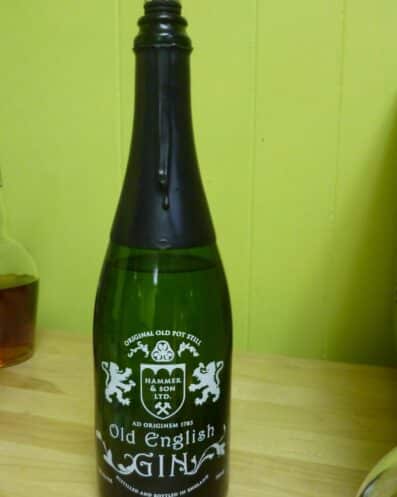Hammer & Son know their history. The story behind their Hammer & Son Old English Gin is deceptively simple: they recreated a 1783 gin recipe, with no detail too small to overlook. It is accurate as one could be to a recipe of this era. They only made one minor adjustment: they didn’t include the turpentine oil. Trust me, this is a modern tweak to the recipe you’ll appreciate. Turpentine oil has two qualities that make it a poor addition to a gin. First (and really foremost), it’s toxic. Secondly, turpentine’s piney-resiny character is used to “enhance” the junipery character of a gin, without having to go through the trouble of distilling it well, or finding good quality juniper. Despite dropping the turpentine, because there’s no way a gin could get to market containing a lethal non-potable substance, they did keep one other trick used by 18th century distillers to mask an inferior product: sweetening.
Hammer & Son Old English Gin is technically an Old Tom Gin. Though not officially labeled one, a sweetening agent has added post distillation; therefore it is an example of the Old Tom style. Old English Gin has company in the sweetened-but-don’t-call-us-an-Old-Tom-gin party; the quite excellent Barr Hill Gin also uses the sweetening while avoiding the pejorative connotations of the category.
As an Old English style, we should expect this to use a more neutral base, probably less “grain” forward, and most definitely not grape-based. We should expect a classic botanical mix, juniper forward, but with a slightly sweeter profile. These are my expectations based on name/history. Let’s see what it actually tastes like.
Tasting Notes
Hammer & Son Old English Gin is perfectly clear in color, no outright evidence of post distillation additions. Definitely looks as if a classic styled gin.
The nose is quite interesting. Juniper forward, but some musky darker notes, wet paper, fallen tree leaves after a rain, hints of angelica and cassia. Quite interesting, and quite evidence that there is something here that may not taste like your usual gins. Despite the colorful descriptors, I don’t think it smells bad or offputting. Those notes, while there, aren’t overwhelming, and while presented on their own, might turn a drinker off. In context though, I think they belie a certain complexity, a depth of character, and they call to mind the notes one might taste in a craft vodka or bright whiskey.
Lots of bright juniper, vivid citrus notes, sweet lemon, orange rind on the palate for Hammer & Son Old English Gin, A soft, almost silky mouthfeel. It feels very thick. The mid body is where some of the earthy complexity comes through: nutmeg, clove, and a hint of a bright floral sweetness towards the end. The finish is long, a bit earthy and indistinct with a touch of heat. The nose doesn’t tell you a whole lot about this flavor, at least not beyond the juniper forward character. Quite nice, and quite complex.
Cocktails
Interestingly enough, when you go to Hammer & Son’s website, a cocktail recipe comes up, and it isn’t quite a cocktail recipe as much as a bold statement on how this gin was traditionally drank:
In all fairness, that’s not really a cocktail. It does have many merits which are well appreciated neat.
As it’s in the Old Tom style, I think it’s good to look at the drinks that generally are made with that style. The Martinez was bright, refreshing, and perhaps brought out some of the woodier, earthier notes in the gin. It’s not quite clear in the drink that you’re working with a sweetened gin as supposed to a regular classic style. I thought it made a robust and interesting Tom Collins though. Again, I think you’re getting a bit more of the darker notes and some juniper, rather than the full picture. Good though.
I also tried it in some ways you might try a classic unsweetened gin. In the martini, I thought the rich silky mouthfeel really enhanced the drink. Lemon, angelica, and a bit of coriander spice reveal themselves with a long slightly outdoorsy finish.
Overall, Hammer & Son Old English Gin
While technically an Old Tom, the sweetening doesn’t define it as much as the carefully balanced, complex palate. Quite good, a good mixing gin and a good gin to be drank neat. Recommended.


Ok. Wow. Thank you for your palate’s diagnosis of Hammer & Son’s Old English GIN. Really. Just bought my first bottle, looking for something different from our usual Tangueray or Bombay, sipped a shot, & told my wife, “smooth, slightly sweet, but not obviously sweet that would put you off,” and doesn’t get lost in tonic. And, love your info about turpentine & sweetening agent. Needed your professional assessment, your “notes,” & “nose” lingo to think about, so my palate could try to catch up. Thank you.
Terrel Fenn
Boston, MA